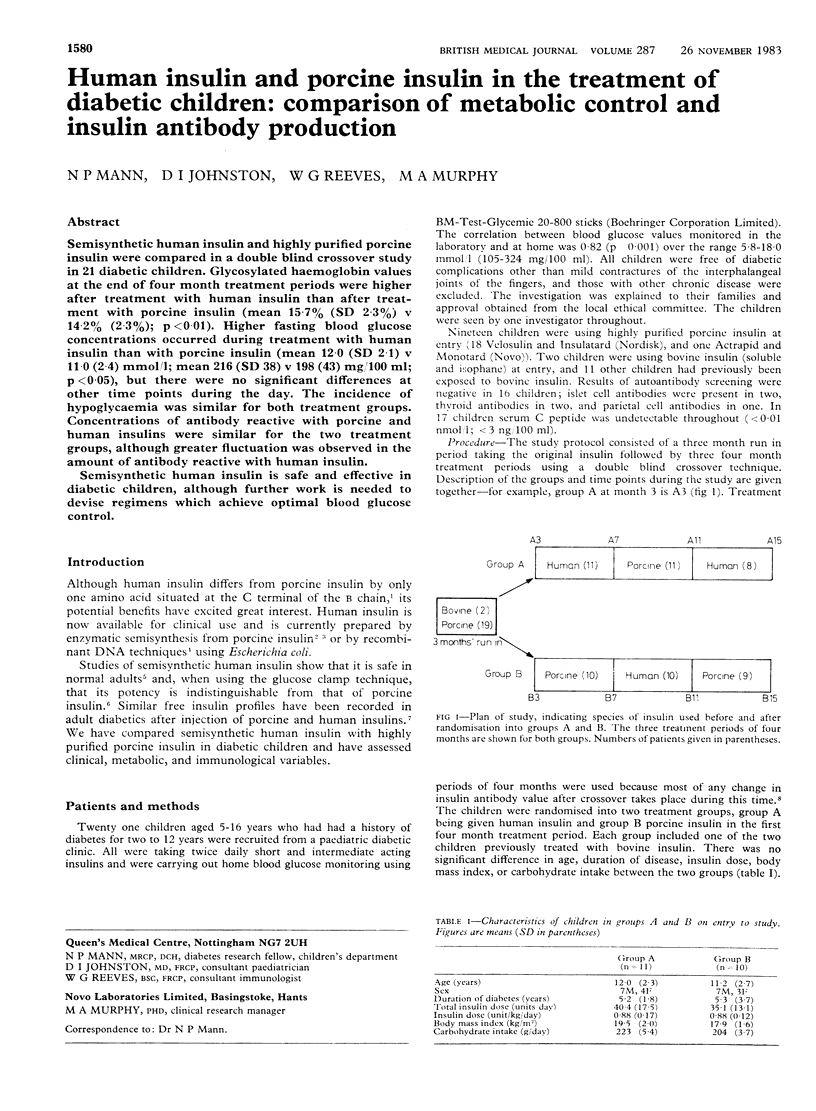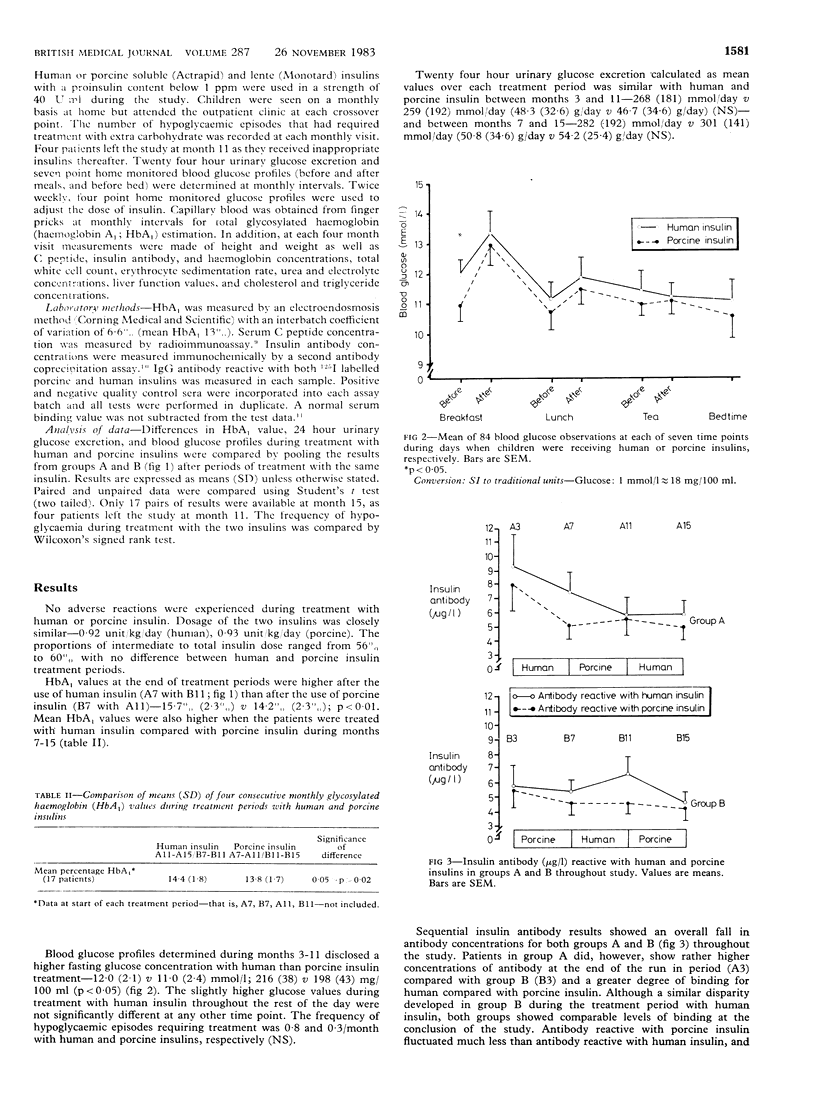Abstract
Semisynthetic human insulin and highly purified porcine insulin were compared in a double blind crossover study in 21 diabetic children. Glycosylated haemoglobin values at the end of four month treatment periods were higher after treatment with human insulin than after treatment with porcine insulin (mean 15.7% (SD 2.3%) v 14.2% (2.3%); p less than 0.01). Higher fasting blood glucose concentrations occurred during treatment with human insulin than with porcine insulin (mean 12.0 (SD 2.1) v 11.0 (2.4) mmol/1; mean 216 (SD 38) v 198 (43) mg/100 ml; p less than 0.05), but there were no significant differences at other time points during the day. The incidence of hypoglycaemia was similar for both treatment groups. Concentrations of antibody reactive with porcine and human insulins were similar for the two treatment groups, although greater fluctuation was observed in the amount of antibody reactive with human insulin. Semisynthetic human insulin is safe and effective in diabetic children, although further work is needed to devise regimens which achieve optimal blood glucose control.
Full text
PDF


Selected References
These references are in PubMed. This may not be the complete list of references from this article.
- Akerblom H. K., Mäkelä A. L. Insulin antibodies in the serum of diabetic children treated from the diagnosis of the disease with highly purified insulins. Acta Paediatr Scand Suppl. 1977;(270):69–79. doi: 10.1111/j.1651-2227.1977.tb15124.x. [DOI] [PubMed] [Google Scholar]
- Andersen O. O. Insulin antibody formation. I. The influence of age, sex, infections, insulin dosage and regulation of diabetes. Acta Endocrinol (Copenh) 1972 Sep;71(1):126–140. [PubMed] [Google Scholar]
- Clark A. J., Adeniyi-Jones R. O., Knight G., Leiper J. M., Wiles P. G., Jones R. H., Keen H., MacCuish A. C., Ward J. D., Watkins P. J. Biosynthetic human insulin in the treatment of diabetes. A double-blind crossover trial in established diabetic patients. Lancet. 1982 Aug 14;2(8294):354–357. doi: 10.1016/s0140-6736(82)90548-7. [DOI] [PubMed] [Google Scholar]
- Deckert T., Andersen O. O., Grundahl E., Kerp L. Isoimmunization of man by recrystallized human insulin. Diabetologia. 1972 Nov;8(5):358–361. doi: 10.1007/BF01218497. [DOI] [PubMed] [Google Scholar]
- Faber O. K., Binder C., Markussen J., Heding L. G., Naithani V. K., Kuzuya H., Blix P., Horwitz D. L., Rubenstein A. H. Characterization of seven C-peptide antisera. Diabetes. 1978;27 (Suppl 1):170–177. doi: 10.2337/diab.27.1.s170. [DOI] [PubMed] [Google Scholar]
- Klier M., Kerner W., Torres A. A., Pfeiffer E. F. Comparison of the biologic activity of biosynthetic human insulin and natural pork insulin in juvenile-onset diabetic subjects assessed by the glucose controlled insulin infusion system. Diabetes Care. 1981 Mar-Apr;4(2):193–195. doi: 10.2337/diacare.4.2.193. [DOI] [PubMed] [Google Scholar]
- Mann N. P., Johnston D. I. Total glycosylated haemoglobin (HbA1) levels in diabetic children. Arch Dis Child. 1982 Jun;57(6):434–437. doi: 10.1136/adc.57.6.434. [DOI] [PMC free article] [PubMed] [Google Scholar]
- Reeves W. G., Kelly U. An immunochemical method for the quantitation of insulin antibodies. J Immunol Methods. 1980;34(4):329–338. doi: 10.1016/0022-1759(80)90105-2. [DOI] [PubMed] [Google Scholar]
- Reeves W. G., Kelly U. Insulin antibodies induced by bovine insulin therapy. Clin Exp Immunol. 1982 Oct;50(1):163–170. [PMC free article] [PubMed] [Google Scholar]
- Ruttenberg M. A. Human insulin: facile synthesis by modification of porcine insulin. Science. 1972 Aug 18;177(4049):623–626. doi: 10.1126/science.177.4049.623. [DOI] [PubMed] [Google Scholar]
- WHITE P. Childhood diabetes. Its course, and influence on the second and third generations. Diabetes. 1960 Sep-Oct;9:345–355. doi: 10.2337/diab.9.5.345. [DOI] [PubMed] [Google Scholar]
- Walford S., Allison S. P., Reeves W. G. The effect of insulin antibodies on insulin dose and diabetic control. Diabetologia. 1982 Feb;22(2):106–110. doi: 10.1007/BF00254838. [DOI] [PubMed] [Google Scholar]
- Walford S. Insulin antibodies, insulin dose, and diabetic control. Lancet. 1983 Feb 19;1(8321):410–411. doi: 10.1016/s0140-6736(83)91518-0. [DOI] [PubMed] [Google Scholar]


